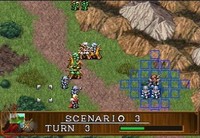|
|

|
PLATFORM
|
Saturn
|
BATTLE SYSTEM
|

|
INTERACTION
|

|
ORIGINALITY
|

|
STORY
|

|
MUSIC & SOUND
|

|
VISUALS
|

|
CHALLENGE
|
Hard
|
COMPLETION TIME
|
60-80 Hours
|
|
OVERALL

|
+ Challenging and varied tactical combat
+ Enormous replay incentive
+ Multiple story options that make a difference in the game
+ Engrossing music
- Judgment system makes keeping troops together hard
- Combat animations have load times
|
Click here for scoring definitions
|
|
|
Langrisser IV could be interpreted as an apology to fans of the series for Langrisser III and its many problems. IV definitely works wonderfully as a return to form for the series, offering complex combat, characters who can be taken down wildly divergent paths via class changes, entertaining music, and meaningful choices by the player. It is not perfect, but this game remaining exclusive to Japan is a cause for sorrow among tactical RPG fans without an import-ready Saturn.
Langrisser IV eschews most of the changes seen in III to revamp the classically epic tactical combat in I and II. Each character under the player's control can hire troops before battle begins, with the troop options expanding as the character gains levels and changes class. Troops are entirely expendable and must be hired again prior to every battle. So long as troops stay within a certain visible distance from their commander, bonuses to their statistics are applied. The troops may not have the same movement range as their commander and can be shifted outside of this bonus range at the player's whim, but the extra statistics imparted by staying close to the commander are usually key to victory. The relationship is symbiotic between a commander and troops, because if the commander is defeated, all of his or her troops instantly die. Troops next to their commander at the end of a turn recover three hit points, and this is a significant number when every unit in the game has ten.
As in most tactical games, the troop types and commander classes fit together into a complex relationship of strengths and weaknesses. Foot soldiers beat pikes, pikes beat cavalry, cavalry beat foot soldiers, archers can strike from a distance in exchange for terrible defense, waterborne troops gain enormous advantages fighting in their home terrain, and holy soldiers gain the advantage over demonic adversaries. Troops also have innate magic resistance that is enhanced by remaining within their commander's bonus radius. Langrisser IV restricts the total troops any commander can possess to four, of one type only.
Langrisser IV also introduces the Judgment system to its combat, with decidedly mixed results. The Judgment system applies agility to the combat proceedings, with units taking actions based upon this statistic. Casting magic also requires a period of waiting before it is carried out, during which time the caster can be waylaid by events. The problem with the Judgment system is that troops and their commanders have different agility statistics, meaning that the two can be forcibly separated for awhile. The symbiotic relationship between commanders and troops makes this vexing. It does affect enemies and the turn order can be viewed at any time, so the problem is not insurmountable.
 The hills are alive with the sound of death!
The hills are alive with the sound of death!
|
|
Otherwise the interaction is simple enough to deal with. Purchasing troops and equipment prior to battle is easy, though the equipment for sale changes without any obvious reason as the game progresses. Character starting positions can be changed at will as the player deems necessary, and this is vital for success in later battles. In order to better plan a character's class changes, the manual will be necessary because only the immediate path branches are shown, and not every possible class along a path. Items do exist to reset a character's progression in order to try it again if this proves an encumbrance. Fortunately, the game can be saved at any time during battle to allow some experimentation in many areas.
Langrisser IV's story begins when a scheming wizard names Gizarov sets off a war between two major nations. His purpose in unleashing a war is to set the pieces in place for his own snaring of enormous power. This setup tears the home village of Landius and Ricky, the two starting characters, to bits, and they ally against Gizarov's federation. Though it initially does not seem related to the prior games in the series, Langrisser veterans will recognize a pair of seemingly immortal faces. There are multiple factions at play in this story, and choices made all along in how to fight and how Landius answers questions from his compatriots will affect which of three major paths is taken. The first half of the game is the setup, and eventually Landius can fight on the side of order, chaos, or against both.
Langrisser III proves an inspiration for IV in one regard, which is that the Landius can attempt to build up the feelings of his female co-combatants towards him. Questions are posed throughout the game, and Landius' answers to them will either build up or tear down his relationships with the women on his team. Unless one has very strong Japanese skills, use of a FAQ is mandatory to have any hope of working through these questions. The woman Landius picks changes the ending a bit, and not much else. The relationship system does at least add an interesting facet to the game.
 Princess Shilfaniel never knew that her father was playing a cruel joke when giving her this headpiece.
Princess Shilfaniel never knew that her father was playing a cruel joke when giving her this headpiece.
|
|
Langrisser IV's visuals are rather detailed, but aside from the plentiful colors and a few spell effects, could have been done on a Super Nintendo. Considering the ease with which the Saturn manipulates these sprites, needing to put up with load times to see attack animations is maddening. Attack animations are disabled by default for that reason.
The score is courtesy of Noriyuki Iwadare working with Makoto Asai and Yuichiro Honda, and while not the greatest set of compositions ever associated with Iwadare, most of the music is quite catchy and varied. Plentiful voice acting is heard throughout the game of variable quality, with Wheeler's seiyuu in particular having a dull monotone, but the good performances more than balance out the weak ones. Career Soft got lazy with the lip syncing, however, showing characters move their mouths at a constant rhythm regardless of what is being said.
Langrisser combat takes time, and battles can easily take hours to complete. The game requires roughly fifty to seventy hours to complete, with one's playing style and the path chosen affecting this number. By the standards of the Langrisser series, IV is not unreasonable in its challenge. Langrisser games are not easy, however, so by a broader standard this should be deemed a fairly difficult title.
For its engrossing tactical combat, its extensive replay value, and its path branches that actually serve a purpose, Langrisser IV is a top-quality game. Its only real detriment, aside from quibbles with the Judgment system, is the game remaining only in Japan. The Saturn's tactical library is full of excellent games, and Langrisser IV deserves acclaim even with the stiff competition on the system. The PlayStation version of this game is not the same as the Saturn, and thus the only way to experience Career Soft's initial take on the game is on its original home. Import-ready Saturn players should do so forthwith.
Review Archives
|









